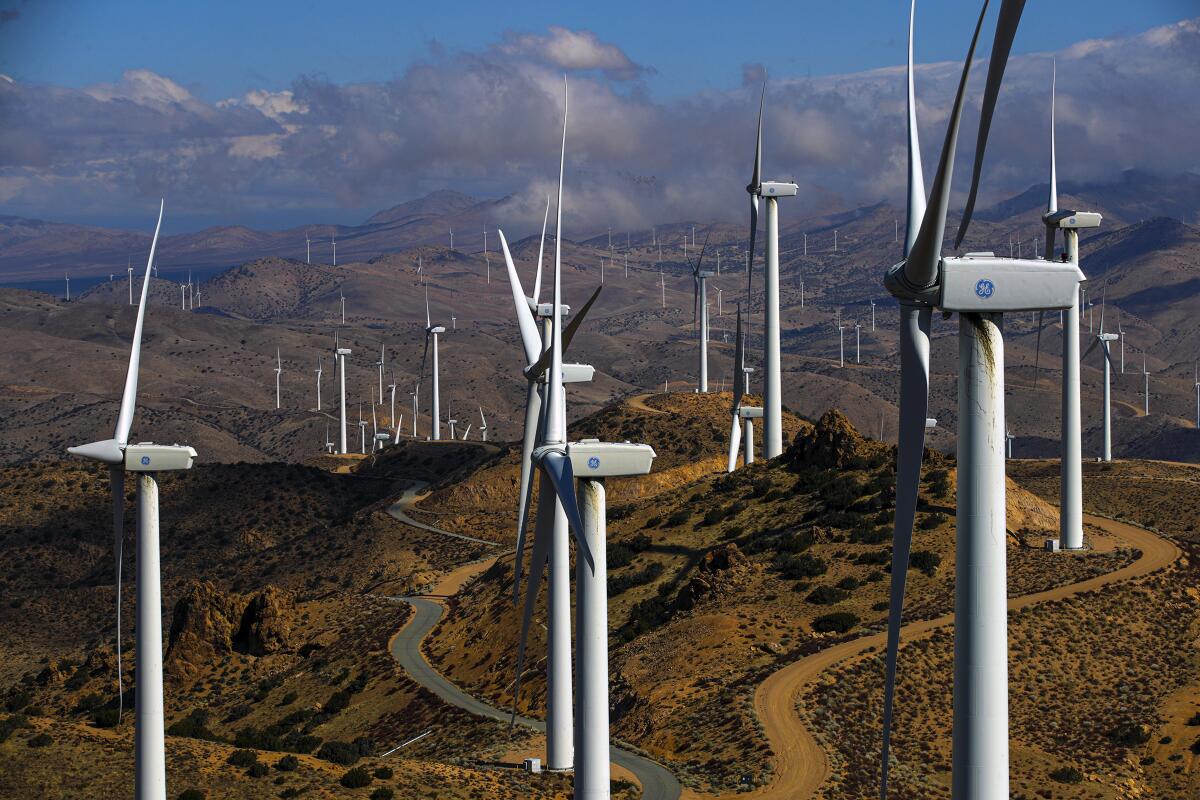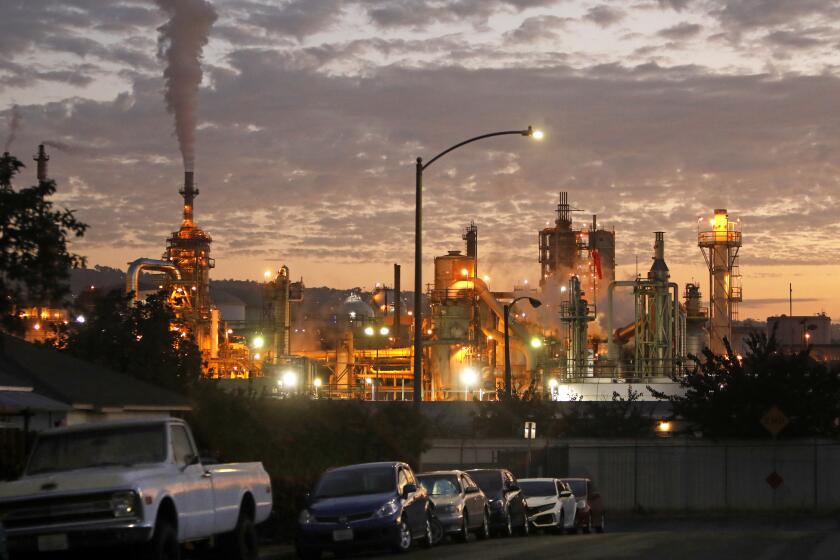California unveils plan to reach carbon neutrality by 2045

California air quality officials released a bold climate plan Wednesday that outlines in broad strokes how the state intends to drastically reduce greenhouse gas emissions by the end of the decade and eventually eliminate its carbon footprint.
The so-called scoping plan released by the California Air Resources Board reflects Gov. Gavin Newsomâs accelerated goal of curtailing planet-warming emissions by 48% this decade compared with 1990 levels. State law requires that Californiaâs emissions be reduced at least 40% by 2030 and 85% by 2045, at which point any emissions from human activity would be offset by natural ecosystems and other solutions.
After months of public meetings and policymaker discussions, this finalized plan gives the clearest picture yet as to how the worldâs fourth-largest economy can meet its ambitious climate targets while maintaining economic growth and accommodating a larger population.
By 2045, the plan envisions a thirty-fivefold increase in zero-emission vehicles and four times the amount of power generation from wind and solar energy â an increase that would avoid the need for new natural gas-burning power plants, officials say. The plan also anticipates that consumer demand for petroleum and natural gas will drop 86% in the next 23 years.
âCalifornia is drastically cutting our dependence on fossil fuels and cleaning our air â this plan is a comprehensive road map to achieve a pollution-free future,â Newsom said. âItâs the most ambitious set of climate goals of any jurisdiction in the world, and if adopted, itâll spur an economic transformation akin to the industrial revolution. While big polluters focus on increasing their profits at our expense, California is protecting communities, creating jobs and accelerating our transition to clean energy.â
As wildfires become more extreme, some worry California will near a tipping point in which its forests emit more carbon dioxide than they absorb.
To curtail carbon dioxide emissions from wildfires, the plan calls for 1 million acres of forests, shrubland, grassland and other habitat to be treated with techniques such as prescribed burning by 2025. That figure rises to 2.3 million acres by 2045. Federal and state managers currently treat about 100,000 acres a year. This would reduce wildfire emissions by 10% compared with a business-as-usual scenario, officials said.
The publication of the state-mandated climate plan lays out an all-important, albeit nonbinding, road map to take concrete action during what is considered the most pivotal decade in the fight against global warming. It will be incumbent on lawmakers and government agencies to pass legislation, establish regulations and earmark funding for climate initiatives that achieve these targets. And the state will need the cooperation of private industry and Californians.
Policymakers hope to avert some of the most dire effects of global warming in a state thatâs been devastated in recent years by unprecedented drought, historic wildfire seasons and record heat waves.
âEveryone in California has experienced firsthand the impacts of climate change,â said Liane Randolph, chair of the Air Resources Board. âIt may have been wildfires and smoke or drought or record-breaking heat waves. The signs are there for all to see. The climate is changing before our eyes. We need to take action to reduce the worst impacts of a changing climate. And thereâs only one way to do that: Break forever our dependence on fossil fuels, the harsh grip of petroleum, and move as fast as we can to a clean-energy economy. And thatâs what this plan does.â
While officials described the plan as âworld-leading,â some policy analysts said they worried the plan offered too little in the way of specifics.
Danny Cullenward, policy director of CarbonPlan, a California nonprofit that analyzes climate solutions, said he was struck by the planâs âlevel of abstractionâ and âtangential relationshipâ to practical reality. âThere certainly isnât a lot of guidance as to which programs need to be tuned up, which ones need to be started and who needs to do what,â Cullenward said.
The plan, which will go before the Air Resources Board for formal consideration next month, hinges on the widespread adoption of zero-emission vehicles â either electric or hydrogen-fueled. The transportation sector, including tailpipe emissions and fuel, accounted for 50% of the statewide greenhouse emissions in 2019. It remains the largest single source of carbon emissions in California.
Officials at the ports of Los Angeles and Long Beach recorded an unprecedented surge in harmful emissions during 2021. They blame COVID-19.
A rule passed this year ensured all new passenger vehicle sales in California will be zero-emission or long-range hybrid by 2035, a bid to phase out gasoline-powered cars. The Air Resources Board is also considering a proposal that seeks to transition heavy-duty trucks by 2040.
While the adoption of electric vehicles has been promising to some, state officials also need motorists to drive less â and California has never reached any of its targets to curtail the number of miles driven. The plan assumes Californians will reduce their miles driven by 25% in 2030 and 30% by 2045.
State officials anticipate the transition to clean vehicles will lead to less oil demand and fewer emissions from refineries, the largest source of emissions within the industrial sector. The plan expects refineries and cement plants to deploy a technology called carbon capture and storage, which involves siphoning smokestack emissions and piping them underground.
This technology, which has not been implemented in California before, has been met with intense criticism from environmental advocates. Many have described it as an unproven technology that may suffer leaks in earthquake-prone state like California. In the final plan, carbon capture and storage is expected to be brought online rapidly starting in 2028.
âCarbon capture is a giveaway to the fossil fuel industry that allows companies to keep business as usual, and relying on it to improve emissions is ludicrous,â said Chirag G. Bhakta, the California director of Food & Water Watch. âGov. Newsomâs support for carbon capture is baffling given his readiness to tax oil companies for their outrageous profits. The only way to truly lower Californiaâs emissions is to cut them at the source, stop issuing fossil fuel permits immediately, and initiate a just transition away from fossil fuels.â
Critics also argue that although carbon capture technology reduces heat-trapping greenhouse emissions, it does not stop the release of such toxic substances as cancer-causing benzene or lung-aggravating particulate matter from industrial smokestacks. Surrounding communities will still suffer health risks from those emissions, they say.
California is embracing carbon capture and storage technology to fight global warming, but critics say it will only increase oil production.
In addition to industry and transportation, the plan envisions significant changes to households over the coming years.
Most residential and commercial buildings in California use natural gas for heating and cooking. Under the plan, however, gas appliances would be phased out in new construction in the next eight years.
The scoping plan calls for only electric appliances to be installed in residential buildings in California beginning in 2026 and in commercial buildings by 2029, which they expect to lead to the installation of 6 million heat pumps (energy-efficient devices used for heating and cooling) installed statewide by 2030.
For existing buildings, the stateâs proposal assumes 80% of appliance sales are electric in California by 2030 and gas appliances are completely phased out by 2035. Calculating for the replacement of old gas appliances over time, the plan anticipates 3 million all-electric households by 2030 and 7 million by 2035.
To that end, California could reduce its natural gas demand 90% by 2045, averting carbon emissions and methane leaks and improving indoor air quality.
This year, the Los Angeles City Council voted to ban most gas appliances in new construction, joining more than 50 other California cities and counties.
If the scoping plan is fully implemented, California would need to generate twice as much electricity to meet the new demand, which state officials say emphasizes the need to invest in renewable energy.
âAll of this is predicated on the build-out of utility-scale wind and solar, having energy efficiency and making sure that there is the ability to connect those sources to points in California where that power is going to be needed,â said Rajinder Sahota, deputy executive officer for climate change and research at the Air Resources Board.
Taken together, the stateâs plan would also achieve 71% reduction in smog-forming nitrogen oxides, as well as roughly $200 billion in healthcare savings by averting premature deaths, hospital visits and illnesses.
âThe plan delivers public health benefits to everyone in California, and most importantly, to those communities suffering from persistent air pollution,â Randolph said.










